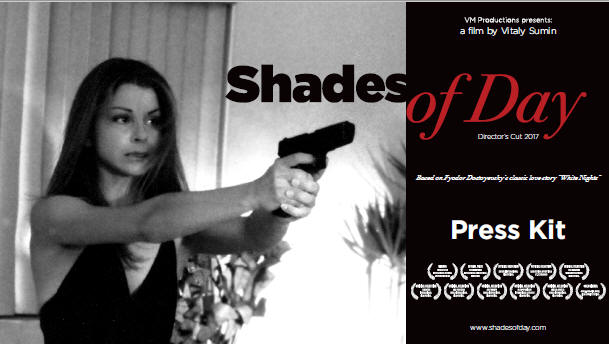Cynematic Elements
Black and White and Color “Shades of Day" is shot in both black and white and color; the shots and sequences in color represent dreams, desires, and hopes. For example, after signing a contract with a movie producer of questionable repute, the lead character of Linda happily relates the turn of events to Sam, her customer at the hotel bar where she works. The skeptical Sam sees Linda in black and white while the dreamer Linda observes him in vivid color.
This black and white to color technique hearkens back to such classics from Hollywood's “golden age” as “The Wizard of Oz” and “The Secret Garden”, where the new Technicolor process was used for the “magical” parts of the films. “Shades of Day” employs the approach with unprecedented subtlety by incorporating color at unexpected places in various scenes. When contrasted with its extraordinary black and white cinematography (which conveys in each frame the “shades” of the title), the effect is stunning and evocative.
Voices Perhaps the filmmakers most daring choice involves sound, specifically the “voices” that are heard by the lead characters. These are the voices of inanimate objects (a desk, a gun, various edifices on Hollywood Boulevard ...) and of the dead (in the film's cemetery scenes). This expands on Dostoevsky's concept in ”White Nights,” where the characters speak to buildings exclusively.
The challenge was to incorporate this surrealistic element without undercutting the reality or the mood of the piece.
After careful consideration, Sumin arrived at a crucial decision as the film went into post-production. Though actors had been cast to provide the “voices,” he replaced them with the lead and supporting actors who appear on screen — their natural voices were altered through technical means and acting technique (different accents, intonations, etc.). The idea was that the “voices” were actually projections of the imagination of the character who hears them and should therefore be based on voices that actually exist in the character's world.
This sound design meshes perfectly with its visual counterpart. The idea was to coordinate sound and picture to capture the subtle interplay of the characters and the “voices” they hear.
Generally, when we hear a “voice,” we're seeing the character who ' s interacting with it. And conversely, when we're hearing the character we're seeing the source of the “voice.” The logic of this motif lies in the fact that, as stated above, the voices are actually ego projections of the characters who hear them.
In one striking scene the lead character of Linda, played by Camilla Bergstrom, has a conversation with a golden pin which had been owned by her stem grandmother. The pin, which speaks with the voice of the grandmother, is actually played by Bergstrom herself - the haunting effect was achieved after extensive sonic experimentation.
Another instance occurs during Linda's job interview with Marsha, the smug, uptight personnel director of a luxury hotel.
Bored by the questioning, Linda engages in an imaginary conversation with Marsha's desk, which attempts to warn Linda about the pitfalls of the position she's applying for, then attempts to woo her, and ultimately is protected by the girl's hand from the pensive tapping of Marsha's pen. The voice of the desk is provided by Brian Paul Stuart, who plays Linda's fiancé Paul. We actually hear Stuart as the desk (though the voice has been altered) before we hear him as Paul. Thus the quirky and comical interaction between Linda and the desk foreshadows the complex relationship between Linda and Paul.
Throughout the film, the “voices” are heard singly, in chorus, and in crescendo in a masterpiece of sound design. Sumin's approach serves to subliminally integrate the dreams and reality of the story.
Visual Elements In “Shades of Day,” with its quality of magical realism, the movie screen had to function as a window looking into a parallel world. The film needed a “ look ” that would capture its singular vision. Enter Gus Blaudziunas, award-winning cinematographer.
Blaudziunas and Sumin collaborated in pre-production for several months, a major investment of time that was necessary to attain the filmic quality required for the story. Chosen locations were meticulously mapped, photographed, and videotaped. Based on this material, the director and cinematographer designed detailed storyboards for each scene and came to a consensus on basic visual elements, composition, key camera movements, and angles, as well as the type of lens to be used for each shot. Thus the style and pace of the movie were determined long before a frame of film was exposed.
![]()



